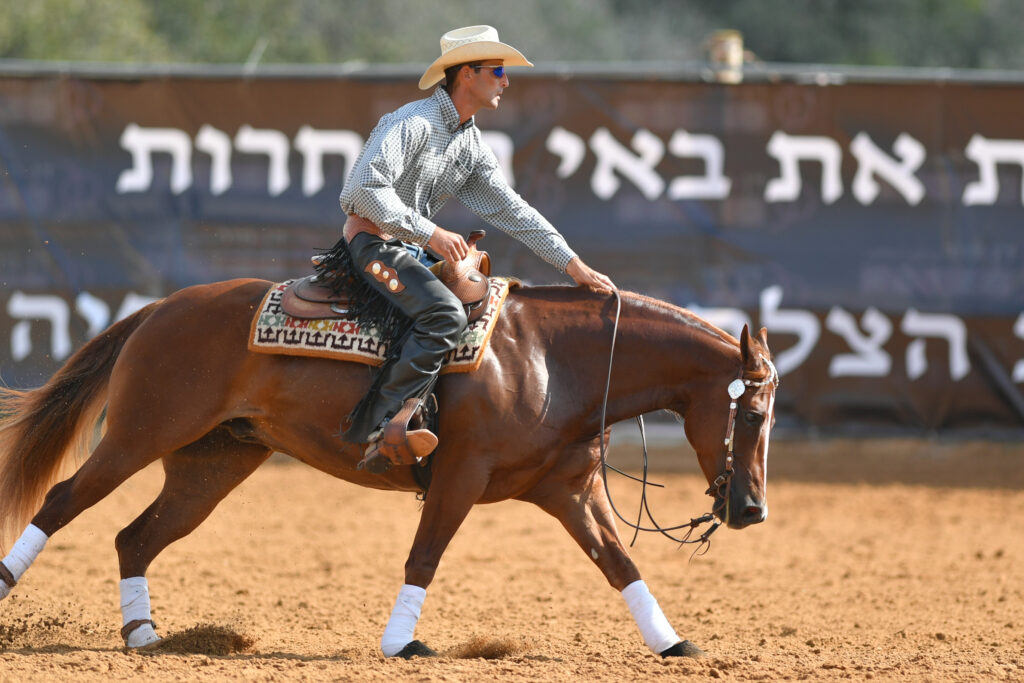This article is brought to you by ADM Forage First Patriot Feeds.
As we bring this series about rider body position to a close, let’s head to the lower half of the body to break down why the position of your ankles, toes, and feet can impact your horse’s movement. Any horseman knows the importance of leg pressure, and how you can communicate to your horse through a slight squeeze of the calves, move of the foot, or shift of your weight. To pull this concept together from the head to the toes, don’t forget to go back and read the first few parts of this series.
Toes Out
I’ve referenced your horse as your dance partner in the past, so let’s continue that metaphor. If you think about doing a ballet plie, consider that the position you want to sit your horse in. If you’re unfamiliar with this movement, allow me to paint you a picture. As you sit your horse, your toes should be out, your knees should have some bend, and there is a straight line from ear, shoulder, hip, to the back of your heel.
When you ride in this position, you open up your seat – and in turn, open the door for your horse to move freely. In my lifetime, I have ridden saddle seat, game horses, gaited horses, foundation bred, and just about everything in between. The main goal of getting your horse to use his body correctly is to help him elevate his back and drive from the hind end. If you ride with your toes straight forward, you’re closing that door.

Try it on the Ground
Let me give you a little homework assignment. Stand up and point your toes straight ahead. Now start walking around, making sure you keep your toes straight ahead. Feel the pressure in your hips? Feel how you almost rock forward a little? When you ride this way, you horse can get forehand heavy.
Now, point your toes about 45 degrees to the outside, and walk around again. You can feel the way your hips open up, and you move more naturally. When you ride with your toes out, your horse can drive from his hind end.
Impact on the Lower Leg
When you ride with a foot pointed straight ahead, you can’t effectively use your lower leg. You end up pulling your heel up, and this shifts your body weight. The only way to properly apply lower leg pressure is to roll your toes out. This allows your lower leg to make contact with the horse. When your toes are out, you’re balancing your body weight better as well.
Use your lower leg to move your horse over. Or, communicate through light pressure to take the brunt of communication off your reins. The reins should not be your end-all-be-all of communication. Bridle reins are not meant to be pulled on. Roll your toes out to that 45-degree angle and watch how you can effectively use your lower leg to communicate.
Don’t Lock Them Up
When I went to WestPoint Military Academy four different times to work with Army mules and soldiers, I saw the importance of this firsthand. When a cadet or soldier stands at attention, they have their toes 45 degrees out, so as to not lock their knees. A soldier standing at attention with knees locked for an extended period, faces the risk of passing out.
I have seen people pass out in the Showmanship ring from standing with their toes pointing square ahead and locking their knees. Think about how this translates to sitting in the saddle with your toes pointing straight ahead, and you can see why rolling those toes out opens up the whole body.

Bring it All Together
We’ve discussed the importance of proper rider body position from the head to the toes. Sitting a horse properly is something that many people have to learn how to do. And we can always be a work in progress. If you want to allow your horse to move properly, understand how your body position affects him.
Roll out those toes and put some bend in your knees. Find your athletic riding position, allow your elbows to flare away from your body a bit, and get out of his way so he can do his job. Be a good dance partner to your horse. Don’t drag him around the dance floor, pushing and pulling to put him where you want him. Speak his language, be aware of your body, and watch your partnership come to life.






